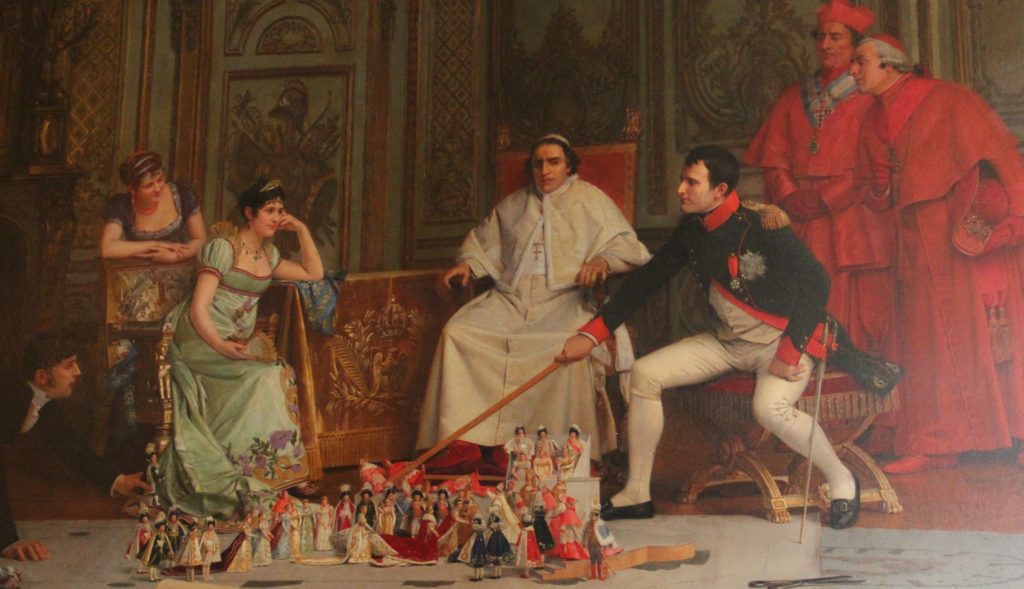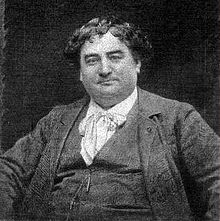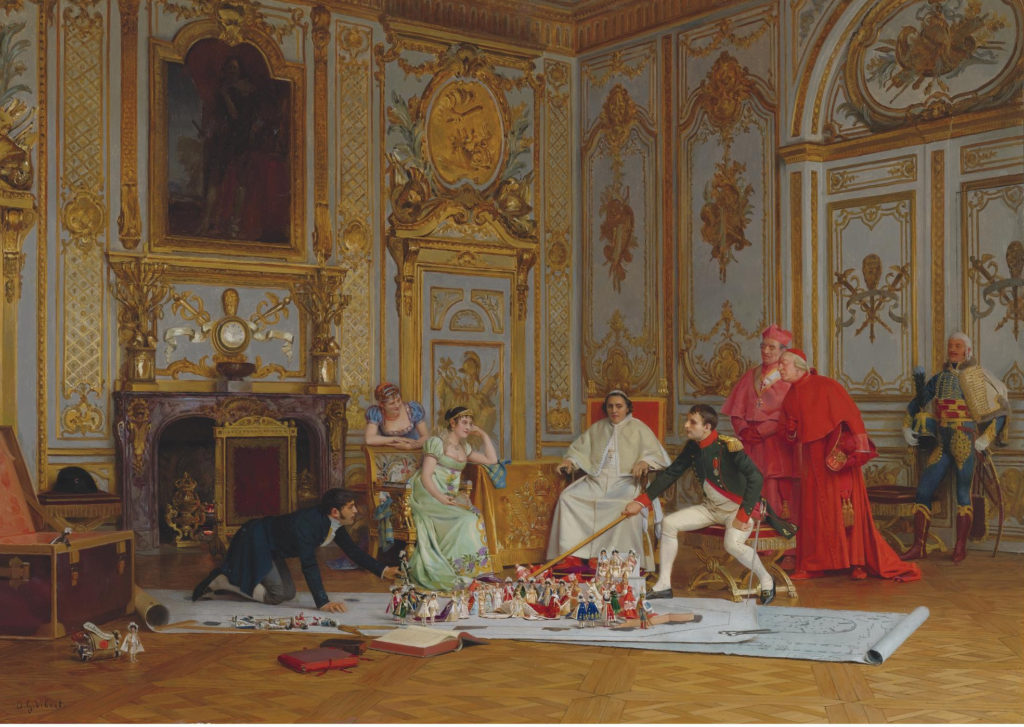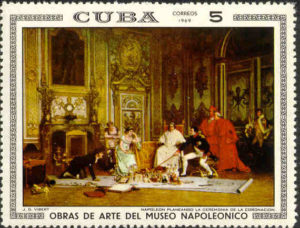
In Cuba’s Museo Napoleónico, my favorite item is Napoleon Bonaparte’s pocket watch (featured in my last post). My second favorite is Jean-Georges Vibert’s painting, Planning for the Coronation. In it, the Consul-for-Life Napoleon Bonaparte is rearranging dolls on a floor plan of Notre Dame Cathedral. If you know Jacques-Louis David’s monumental painting, Le Sacré (The Coronation), you’ll recognize the mimicry.
A little history: in 1802, the French voted in a referendum to make First Consul Napoleon Bonaparte “consul for life.” In 1804, after another referendum, he was proclaimed “Emperor of the French,” with hereditary rights for his descendants.
 In Vibert’s painting, Napoleon is rehearsing his coronation as Emperor. All the key players are there. Josephine—soon to be Empress—is looking rather bored. Trusting in her exquisite taste, Napoleon had charged her with planning the celebration. She enlisted one of her favorite painters, Jean-Baptiste Isabey, to work out the details. He’s the one on his knees setting up the dolls he’s made to represent the participants.
In Vibert’s painting, Napoleon is rehearsing his coronation as Emperor. All the key players are there. Josephine—soon to be Empress—is looking rather bored. Trusting in her exquisite taste, Napoleon had charged her with planning the celebration. She enlisted one of her favorite painters, Jean-Baptiste Isabey, to work out the details. He’s the one on his knees setting up the dolls he’s made to represent the participants.
Overlooking it all, a reluctant Pope Pius VII clutches the arms of his chair. He’s visibly uncomfortable with the deal he made for the Roman Catholic Church to support Napoleon’s rise to Emperor. As if to confirm Pius’s mistake, Napoleon Bonaparte bats aside two dolls dressed in cardinals’ robes. Those two real-life cardinals peek over the Emperor-to-be’s shoulder. Napoleon, with his epaulettes, medals, sword and pointer, dominates the scene as he will dominate all of Europe for the next decade.
Vibert (1840-1902) painted Planning for the Coronation many decades after the event, undoubtedly drawing on the David painting for inspiration. Isabey’s use of dolls is historically correct. Apparently, some of them still exist in the Musée de l’Armée in Paris. David, too, used dolls as models, but he didn’t show the ceremony exactly as it happened. He rearranged the participants to suit his artistic and propaganda purposes. For example, the dolls on a raised platform at the pope’s left foot include one of Napoleon’s mother. As a good republican, she disapproved of Napoleon crowning himself emperor and refused to attend. While Vibert perpetuates David’s myths, both paintings do capture the essence of history.
History of the Painting

Vibert painted two versions of Planning for the Coronation. In 2009, Sotheby’s resold the smaller of the two (pictured directly above). According to the auction house, the Museo Napoleonico’s is the larger, “measuring 39 by 55 inches . . . owned by J.P. Morgan in the late nineteenth century before passing through subsequent private collections until its sale in New York at Parke Bernet in 1953” to the Cuban sugar king Julio Lobo. Sotheby’s states that the smaller version was on display in the French pavilion at the St Louis World Fair of 1904. That fair was formally known as the Louisiana Purchase Exhibition, as it celebrated the 100th anniversary of the United States’ purchase of the Louisiana Territory from Napoleon Bonaparte.

As a last note, in 1969, Cuba issued a series of stamps highlighting paintings from the Museo Napoleónico. Among them was this stamp of Planning for the Coronation. Governments generally issue stamps like this to raise funds from collectors. I wonder whether Julio Lobo, who was then nine years into his exile, was bitter or proud to see his former property benefiting the Cuban revolutionary government.

Hi Margaret,
A small correction/clarification to the above.
The copy is smaller (approximately 40% the size of the original) and is on canvas as opposed to the wood of the original. The first and only time the copy was publicly displayed was at the World’s Fair but it was in the collection of the Ed. Pinaud perfume company of Paris. It then passed to a private Chicago collector, and then to another private collector in 1975. In April 2009, it was sold by Sotheby’s into private hands for $84,100.00.
The original (in the collection of the Museo Napoleonico) was likely first purchased by J.P. Morgan, the wealthy American industrialist. Morgan had a rather large collection of other Vibert paintings. Upon his death, the painting was bequeathed to his daughter, Juliet P. Hamilton (nee Morgan).
After her death, this painting was put up for auction by Hamilton’s estate in January 1953, at the Parke Bernet Galleries in New York. It sold for $9,250 to Oscar Cintas, the former Cuban ambassador to the United States, prominent railway and sugar magnate, and patron to the arts.
In his lifetime, Cintas assembled an art collection considered to have no rival in Latin America. In addition to artwork, he collected manuscripts that included the only first edition of Don Quixote known at the time and the final manuscript of Lincoln’s Gettysburg Address, which is now displayed in the Lincoln bedroom at the White House in Washington. With the Cuban Revolution of January 1959, Cintas’ properties were claimed by the Cuban government and “Napoleon Planning His Coronation” was deposited in the newly established Museo Napoléonico in Havana.
Thanks for all the details, Luke. Your comments were so meaty that I turned them into their own blog post!FINDING NAPOLEON PART 3 (CORRECTION)
Oscar Cintas looks like a really interesting guy. I checked Rathbone’s “Sugar King of Havana” and didn’t see any mention of him, but Julio Lobo and he must have been competitors (friendly or not so friendly). It would be interesting to know. Also I wondered if how much of Havana Art Museum’s European Masters Collection was his and how much Lobo’s. Unfortunately, that section of the museum was closed when I was in Havana.
Thanks again!
Margaret